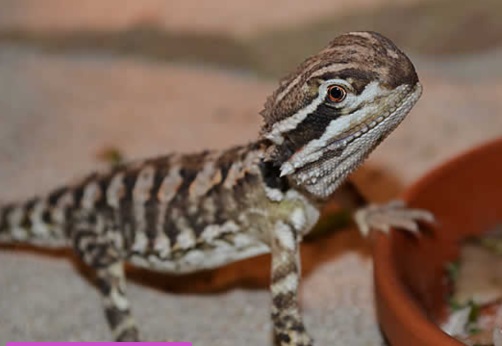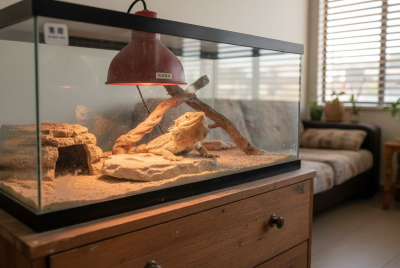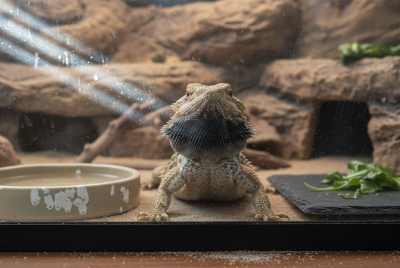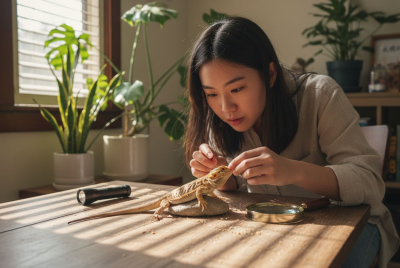Rankin Bearded Dragon: A Complete Care Guide
If you’re anything like me and have a passion for reptiles, the Rankin dragon is probably on your radar. This smaller cousin of the more common central bearded dragon has a lot to offer in terms of personality and manageability. In this guide, I’ll walk you through everything you need to know about Rankin bearded dragons, from their care requirements to their unique characteristics. Whether you’re a new pet owner or a seasoned reptile enthusiast, I’ve got you covered!
Introduction to Rankin Bearded Dragons
Rankin bearded dragons, also known as Pogona henrylawsoni, are a smaller, lesser-known species of bearded dragon. Despite their size, they have big personalities and are a great option for those looking for a reptile with manageable care needs. Let’s dive into what makes these dragons special.
What is a Rankin Bearded Dragon?
While they are often overshadowed by their larger cousin, the central bearded dragon (Pogona vitticeps), Rankin bearded dragons are gaining popularity among reptile enthusiasts for their smaller size and docile nature.
The Difference Between Rankin and Standard Bearded Dragons
The most obvious difference between Rankin and central bearded dragons is their size. Rankins are much smaller, typically growing to around 10-12 inches, while central bearded dragons can reach up to 24 inches. This makes them an excellent choice for those with limited space or who prefer a more compact pet.
The Origin and Natural Habitat of Rankin Bearded Dragons
Rankin bearded dragons are native to Australia, specifically in the arid and semi-arid regions of Queensland. They are well-adapted to hot environments with rocky terrain, making their care in captivity similar to that of their larger counterparts, but with a few tweaks.
Physical Characteristics of Rankin Bearded Dragons
Rankin dragons have all the charm of larger bearded dragons but come in a more manageable package.
Size and Appearance
As mentioned, Rankin dragons are smaller, usually growing between 10 to 12 inches in length. They have a stout body and a spiky “beard” that can puff out when they are stressed or excited. Their smaller size makes them easier to handle, especially for younger or less experienced reptile keepers.
Color Variations
Rankin bearded dragons generally have earthy tones like tan, brown, and gray, which help them blend into their natural surroundings. However, some breeders have started producing morphs with brighter colors, similar to those seen in central bearded dragons.
Personality and Temperament
One of the main reasons I love Rankin bearded dragons is their friendly, sociable nature. They are curious and seem to enjoy human interaction, making them great pets for both beginners and experienced keepers.
Friendly and Sociable Nature
Rankin dragons are known for being docile and easy to handle. Unlike some reptiles that prefer solitude, these little guys often seem to enjoy spending time with their owners. With regular handling, they become even more comfortable with human interaction.
Comparing the Behavior to Other Bearded Dragons
Compared to their larger relatives, Rankin bearded dragons are a bit more active and inquisitive. They enjoy exploring their environment and will often bask under their heat lamps or watch their surroundings with keen interest.
Housing Your Rankin Dragon
Providing the right habitat is crucial for keeping your Rankin bearded dragon happy and healthy. While they don’t need as large an enclosure as central bearded dragons, they still require a setup that mimics their natural environment.
Ideal Tank Size and Setup
For a Rankin bearded dragon, a 20-30 gallon tank is usually sufficient for an adult. They don’t need as much space as larger bearded dragons, but they still appreciate room to explore and bask. Make sure to include plenty of hiding spots, branches for climbing, and flat rocks for basking.
Substrate Choices
The substrate in your dragon’s tank is important for their comfort and health. Many owners prefer reptile carpet, paper towels, or tile as a substrate because loose substrates like sand can pose a risk of impaction if ingested.
Basking Areas and Hiding Spots
Like all reptiles, Rankin dragons need a basking area where they can warm up. You should provide a heat lamp that keeps the basking spot at around 95-100°F. Additionally, provide several hiding spots where they can retreat and feel safe.
Lighting and Temperature Needs
Rankin dragons, like all bearded dragons, are ectothermic, meaning they rely on external sources of heat to regulate their body temperature.
UVB Lighting Requirements
UVB lighting is essential for the health of your Rankin bearded dragon. This light helps them synthesize vitamin D3, which is necessary for calcium absorption and bone health. Make sure to provide UVB lighting for 10-12 hours a day.
Maintaining Proper Temperatures
In addition to the basking area, the cool side of the tank should stay between 75-85°F. This temperature gradient allows your dragon to thermoregulate, moving between warmer and cooler areas as needed.
Diet and Feeding for Rankin Bearded Dragons
Rankin bearded dragons are omnivores, meaning they eat a mix of insects and plant matter. A well-balanced diet is crucial for their health.
Staple Foods and Recommended Diet
For young Rankin dragons, insects like crickets, dubia roaches, and mealworms should make up the majority of their diet. As they age, you can shift their diet to include more greens and vegetables like kale, collard greens, and squash. For adults, aim for a diet that’s about 70% plant-based and 30% protein.
Hydration Tips
While Rankin dragons get most of their hydration from their food, it’s still important to provide a shallow dish of fresh water in their enclosure. Misting their enclosure occasionally can also help with hydration, especially during shedding.
Health and Wellness of Rankin Bearded Dragons
Keeping an eye on your dragon’s health is key to ensuring a long, happy life.
Common Health Issues
Like other bearded dragons, Rankin dragons can be prone to metabolic bone disease (MBD) if they don’t get enough UVB light or calcium in their diet. Other potential issues include respiratory infections and parasites, which can be prevented with proper care and hygiene.
Signs of a Healthy Rankin Dragon
A healthy Rankin bearded dragon will have clear eyes, smooth skin, and a strong appetite. They should be active during the day and exhibit natural behaviors like basking and exploring their environment.
Handling and Socialization
Rankin bearded dragons are generally easy to handle, but proper technique is important to ensure their comfort and safety.
How to Handle Your Rankin Bearded Dragon Safely
When picking up your Rankin bearded dragon, always support their body, especially their legs and belly. They are generally calm and don’t mind being held, but be gentle and avoid sudden movements.
Socializing with Humans and Other Pets
Rankins are social and can be handled regularly. However, always supervise interactions with other pets, as larger animals can easily stress or injure them.
Breeding Rankin Bearded Dragons
If you’re considering breeding Rankin bearded dragons, there are a few important things to know.
Tips for Successful Breeding
Breeding Rankin dragons isn’t too different from breeding other bearded dragons. Ensure you have a healthy pair and provide a proper nesting area for the female to lay her eggs. Once the eggs are laid, they’ll need to be incubated at the right temperature and humidity levels.
Raising Rankin Bearded Dragon Hatchlings
Caring for hatchlings requires close attention to their diet and environment. Hatchlings will need more protein than adults, so feed them a variety of small insects multiple times a day.
Conclusion
Rankin bearded dragons may be smaller than their larger cousins, but they are just as rewarding to keep. Their manageable size, friendly temperament, and relatively easy care make them a great choice for reptile enthusiasts of all experience levels. With proper care, your Rankin bearded dragon will thrive and bring you years of enjoyment.
FAQs
1. How long do Rankin bearded dragons live?
A: With proper care, Rankin bearded dragons can live between 8-12 years in captivity.
2. Are Rankin bearded dragons good for beginners?
A: Yes, their smaller size and friendly nature make them a great option for beginners.
3. Can Rankin bearded dragons live with other reptiles?
A: Rankin dragons can sometimes be housed with other dragons of the same species, but it’s best to avoid mixing them with different reptiles.
4. How often should I feed my Rankin bearded dragon?
A: Young Rankin dragons should be fed insects daily, while adults can be fed every other day with a mix of vegetables and insects.
5. Do Rankin bearded dragons need baths?
A: While not necessary, occasional baths can help with hydration and shedding. Make sure the water is shallow and lukewarm.




